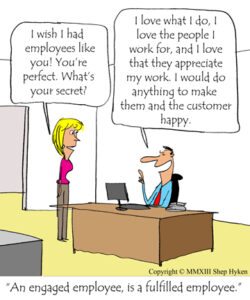 The term engagement has been around for a long time. I first learned about it 20 years ago and after reading the book First Break All the Rules and attending workshops led by Marcus Buckingham; I wanted to use the concepts with clients. A few years ago Karen Boublis and I created programs to teach business owners how to improve the engagement of their employees which would impact recruitment, retention and the biggie, performance.
The term engagement has been around for a long time. I first learned about it 20 years ago and after reading the book First Break All the Rules and attending workshops led by Marcus Buckingham; I wanted to use the concepts with clients. A few years ago Karen Boublis and I created programs to teach business owners how to improve the engagement of their employees which would impact recruitment, retention and the biggie, performance.
Sadly, just as servant leadership takes time and commitment so does engagement. the concepts are aligned. Servant leadership promotes engagement and engagement is enhanced and able to flourish with servant leadership.
Below is an excerpt from a book that demonstrates in the last 20 years engagement has not really improved (thanks to Steve Zuback for the article) Now we have a pandemic that helped create the great resignation and frustration over the inability to hire. Can this be fixed? YES it takes time and commitment.
It means creating a workplace with a culture that develops and encourages all employees. it is based on communication, respect, trust, and aligned values. It is being willing to make changes to model the desired behavior and stay the course. It can be done.
imagine what could happen if more people were engaged in the workplace and their careers. If you want to learn how just send an email and let’s talk harriet@trainingsolutions-hlc.com
It’s the Manager By, Safi Bahcall
“Gallup Finds That the Quality of Managers and Team Leaders Is the Single Biggest Factor in Your Organization’s Long-Term Success.”
“According to extensive research carried out by Gallup, a global expert in employee attitudes and behavior, only 15% of employees around the world are engaged in their work. The other 85% feel like they’re just putting in time, or worse, they actively hate their jobs and companies. What this means is that only about 15% of the workforce at a typical organization is driving any innovation or insight. Of course, this is a rough approximation that varies widely across different types of companies. But whether an organization aligns with this particular ratio or not, say authors Jim Clifton and Jim Harter, any percentage of disengaged employees represents a significant drag on business potential.” “When employees are disengaged, productivity – and profitability – are negatively impacted. As many as 85% of employees are actively disengaged, or hate their jobs. So, it’s simply good business to ensure that employees are happy. Understanding what today’s workers want – to work towards a shared goal and have opportunities for development – is the first step toward creating a positive, engaged work environment. The key lies in the manager, and their ability to communicate and support the needs of their team members, helping them to achieve fulfillment with their jobs, and shape successful development paths.”
Recent Comments